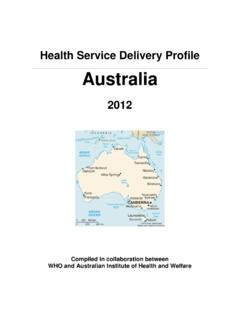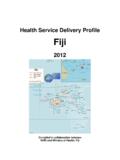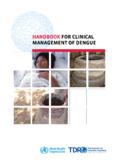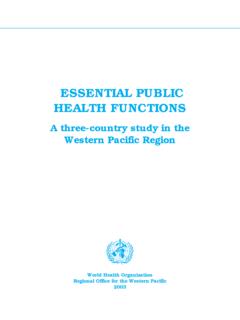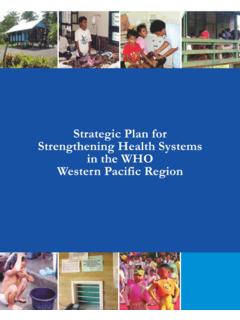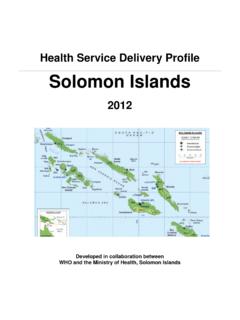Transcription of National Health Strategic Plan - WHO Western Pacific Region
1 The People of the solomon islands will be Healthy, Happy, and Productive! National Health Strategic plan The Ministry of Health & Medical Services solomon islands GOVERNMENT 2011-2015 March 2011 Table of Contents Minister s Foreword .. 4 Permanent Secretary s Overview .. 5 List of Acronyms and Abbreviations .. 7 Overall Health Sector Goal, Vision, Mission .. 8 Goal .. 8 Vision of Future solomon islands Health .. 8 Mission of the Health Sector .. 8 Definition of Needs for Strategic Change .. 8 Substantive Profile & Needs .. 8 Organisational Profile and Needs .. 16 Operating environment and context .. 16 The Structure of the Ministry of Health & Medical Services (MHMS) .. 20 Resources and Management System .. 21 Values and Operating Principles: (see Annex II for more complete definitions) .. 24 Concept and Utility of Values.
2 24 Operating Principles: .. 25 Concept and Utility of Operating Principles - .. 25 Policies: .. 26 Substantive Policies and Relative Priorities .. 26 Policies & Relationships to Existing Programs and Services .. 26 Organisational Policies and Priorities .. 27 List of Policies & Relationship to Existing Organisational Units & Functions .. 28 Priority Substantive Policies related to Priority Organisational Policies .. 28 Overall Strategic Focus: .. 29 Policies, Strategies, Objectives, Activities, Indicators and Resources .. 30 Substantive National Health Policies .. 30 Organizational Policies .. 34 Monitoring and Evaluation .. 37 Monitoring Processes & Timing .. 37 Evaluation Processes & Timing .. 41 Monitoring Indicators What will be monitored? .. 42 Funding & Strategic Changes .. 45 Implementation Arrangements .. 47 Operational Plans relationship to the NHSP.
3 47 Annex I .. 48 Background & Definition of Needs for Change .. 48 Double Disease Burden .. 49 Consensus of Communities Views and Health -related Behaviors .. 50 The Health System .. 51 Ministry of Health and Medical Services (MHMS) as an Organization .. 52 Annex II .. 54 Values more complete explanation .. 54 Operating Principles: more complete explanation .. 55 Annex III .. 57 4 Minister s Foreword It is my pleasure as the Minister responsible for Health matters to launch the 2011 to 2015 National Health Strategic plan (NHSP) for the Ministry of Health and Medical Services (MHMS). This National Health Strategic plan identifies how the MHMS will deliver on a range of substantive policies (those related to the business of Health ), including the Government s NCRA policy priorities related to Health . The National Health Strategic plan also defines the MHMS overall goal, vision, and mission for this medium term period.
4 It also outlines the organizational policy priorities required to improve the Ministry s internal functions and operations so that it is better able to achieve the substantive policies for the people of the solomon islands . This is all central to fulfilling the lead part of the vision statement on the cover page of this plan , The People of the solomon islands will be Healthy, Happy, and Productive! The MHMS is the major provider of Health services in the solomon islands . While there are some faith-based organizations (FBO) and NGO s that provide a proportion of the nation s Health services, in total they are less than 15% of outpatient and inpatient services. Significant proportions of the funding for the services of these FBO s and NGO s is provided by the Government through the MHMS, and the MHMS accounts for these services in their planning and overall management of the Health sector.
5 As a result, there is very little overlap of FBO and NGO services with MHMS services which is rare. In many countries these services do overlap and duplicate. Also while a few private Health and medical services are available in the country (mostly in Honiara), they provide an insignificant proportion of the nation s total services probably 2-3 percent. This is good as countries where private services are the dominant form of service delivery (the United States for example) result in very high costs and poor Health outcomes for the money spent. The United States has the least cost-effective Health sector of any industrialized nation, while the UK, which remains 85% in the public sector, is the most cost-effective.. This NHSP is a record of the policy and strategy decisions the MHMS made which will guide myself and the MHMS Executive team in high level management of the Ministry and overall stewardship of the solomon islands Health sector.
6 Any modern Health sector in any country is very difficult to plan and manage as there are so many aspects to Health . Also due to major advances in medical and Health sciences and technology many services have become very expensive such that no country can now afford to implement everything that is technically and clinically possible we must, like all other countries, set clear priorities and the NHSP does that. Due to the wide variety of services needed and the need to adjust services to the needs of the people in every location, the NHSP is linked to many more detailed operational plans of National programs, a plan for each province, and the National Referral Hospital. I wish to sincerely acknowledge the dedication and effort of all staff, under the leadership of the Permanent Secretary, for the formulation of the 2011-2015 National Health Strategic plan (NHSP).
7 Hon. Charles Sigoto MP Minister for Health and Medical Services 5 Permanent Secretary s Overview Recently (2006) the solomon islands was the poorest country in the Pacific Region by GDP per capita. Nevertheless, it has produced some of the better Health outcomes for the money it spends on Health . It is at or above the total disease burden level compared to countries of similar socio-economic levels. The top 20 causes of morbidity and mortality indicate the country is dealing with the double disease burden of both communicable and non-communicable diseases. The country is in mid-phase of epidemiological transition; therefore, they have to deal with both the control of infectious diseases and the increasing incidence of non-communicable diseases, with limited resources. Nevertheless, an analysis of basic Health status indicators shows an average annual incremental increase of the last 4 years.
8 Recent increasing in funding for the Health sector has been dramatic. Since 2005 MHMS budgets have increased in real terms per capita at an average annual rate of over 16%! The actual spending from 2006 to 2009 increased also in real terms per capita by 19% per year. Both as a percentage of GDP and the percentage of SIG total revenues (4-5% for the former and 9-16% for the latter) the allocations to Health are high for a country of the solomon islands status relative to countries of similar socio-economic levels. The per capita expenditure has also risen significantly since 2005 when it was at Sol$ 299/capita and increased to $533 budgeted in 2010 ($462 actually spent in 2009). However, much of those increased funds for the MHMS as a whole have returned sub-optimal Health outcomes for the following reasons: The MHMS is very top heavy and resources are very centralized Most organizational functions are operated in a very ad hoc manner the development of systems and good system operation has not been a priority; There has been organizational proliferation at the central level for years.
9 Human resource planning, development, and management are also very unsystematic and these three core functions seem generally un-integrated. Because the MHMS has generally been locked in the medical model approach to the delivery of Health service since independence, there are many distortions in funding allocations and managerial priorities. Contrary to the last 5-year period, currently it is expected that the funding for the Health sector will not increase in real terms, per capita over the next five years. If it does increase, it will likely be a very, very small increase. Therefore, the next five years will continue to be challenging for the solomon islands Government in ensuring the quality of Health care services to the people is improved and increasingly accessible, especially for the majority of the populace who live in the rural areas.
10 The solomon islands Government through the Ministry of Health and Medical Services (hereinafter MHMS) has developed Health policies and strategies in the National Health Strategic plan 2011-2015. These conform to the central Government s policy statements for Health . Given the above, the Government is 6 planning to strengthen existing services mostly within existing community services and through existing facilities. As part of this service improvement there will be an emphasis on Health staff development, including preparation of the first National human resource plan for Health . The policy statements for Health are divided into two categories. The first category is substantive those policies which relate to the programmatic and technical aspects of Health and medicine, or those which define the business of Health .
